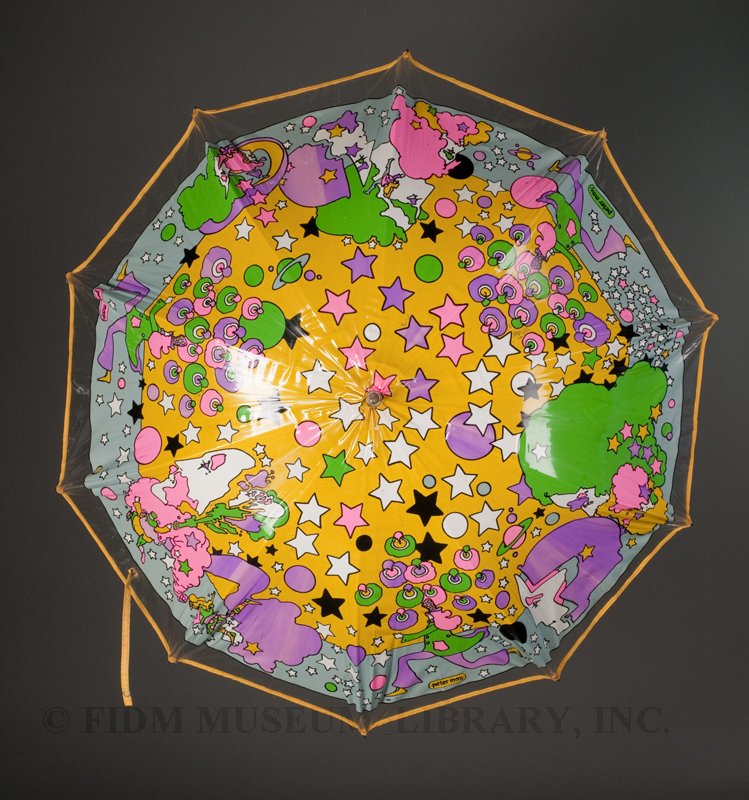Peter Max umbrella, c. 1968-70
The kaleidoscopic vision of this umbrella cover is the trademark style of Peter Max (b. 1937), New York's East Village illustrator who gave the hippie generation its far-out graphics for Central Park "Be-Ins" and Woodstock-era rock 'n' roll concerts. Influenced by early-twentieth-century Fauvist artists—particularly Pablo Picasso (1881-1973) and Henri Matisse (1869-1954)—as well as his childhood comic books, Max designed this chromatic burst of twenty-two human faces and figures morphing into another. Stars and moons circle in a kinetic rhythm of psychedelic colors titled "Astrological Astroplane," attesting to the artist's deep interest in astrophysics. In reference to this era, Max wrote: "My Cosmic period of the late sixties was a visual translation of the euphoria and expansion I experienced during those times. It seemed that art was no longer something I did, but something that happened to me."1
 Umbrella
Umbrella
c. 1968-70
Peter Max, Illustrator
Museum Purchase
2007.5.11
As a graphic artist, Peter Max had a simple goal: “I want to turn the world into a gallery…I want a beautiful world. I am going to make it a Peter Max world.2 Max pursued this objective by licensing his illustrations to manufacturers who produced a host of products. In the late 1960s and early 1970s, Max' illustrations appeared on a dizzying array of consumer goods: scarves, cosmetic packaging, pens, neck-ties, shoes, garments, linens, clocks, posters, lunch boxes, stationary, even United States postal stamps. Max' graphics also appeared in television commercials, including ads for 7 Up and the American Cancer Society. In 1971, Max estimated that his illustrations had been reproduced 75 billion times.3 Though Peter Max' distinct illustration style was a signature in itself, most of the licensed products also featured his name somewhere in the design. Can you spot the words "Peter Max" on our umbrella?
Though Peter Max made a fortune licensing his illustrations, he also considered the distribution of his work a kind of public service. Max believed strongly in the power of positivity and believed that his bright, light-hearted illustrations of stars, rainbows, and smiles made the world better, and more positive. Mass production was simply an extension of this belief; a wide range of products allowed more consumers access to Max' positive visual messages. Max didn't claim credit for the impact of his work, but attributed it to a "cosmic force." In 1969, Max stated, "It's not me covering the world [with my illustrations], it's some great cosmic force working through me."4
1 Riley, Charles A. The Art of Peter Max New York: Abrams, 2002: 23.
2 Shulte, Ellen. "How Peter Max Struck It Rich at 28." Los Angeles Times 30 Jan 1969: g14.
3 Krier, Beth Ann. "An Artist's Feats in Shoe Design: Peter Max Shoes." Los Angeles Times 25 Aug. 1971: G1.
4 Martin, Judith. "Happy, Hip Peter Max" The Washington Post 16 Nov. 1969: F1.